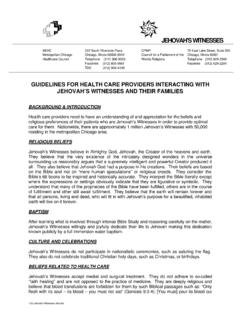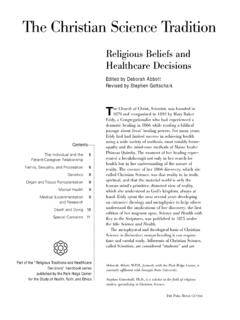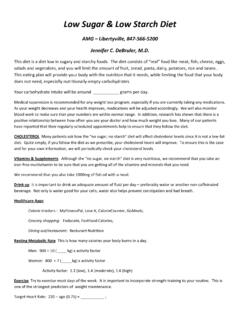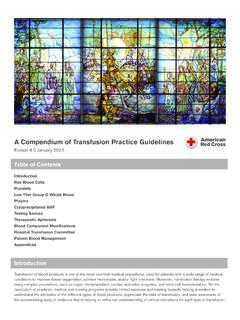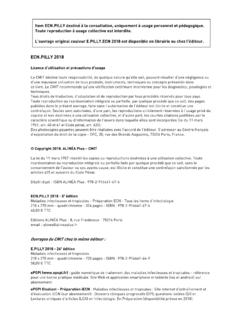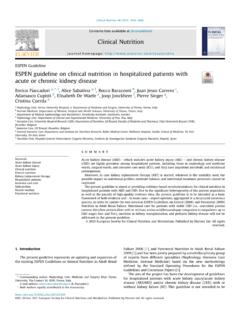Transcription of The Hindu Tradition - Advocate Health Care
1 THEPARKRIDGECENTERThe Hindu Tradition is one of the oldest living reli-gious traditions of the world. Identifiably Hindupractices and objects have been traced to what usedto be called the Indus Valley culture but is nowreferred to increasingly as Harappan culture, after itsbest-known archeological site. This culture was con-temporaneous with the earliest indications of civiliza-tion in Egypt, Mesopotamia, and relationship of this culture to the Vedas, thefoundational texts of Hinduism, remains obscure. Theearliest of these Vedic texts, called , hadbeen compiled by 1200 , according to mostscholars.
2 Its appearance commences the age of Vedicculture, which lasted until around the fourth By the sixth century , religious life inIndia was already in ferment as a result of the gradualdissolution of the Vedic sacrificial worldview, and outof this ferment emerged the other two great religioustraditions of ancient India: Buddhism and interaction of the Vedic Tradition with these tradi-tions gave rise to what is usually referred to as classi-cal classical Hindu Tradition , while it underwentnumerous transformations and remained in continu-ous interaction with both Buddhism and Jainism.
3 Wasthe main religion of the Indian sub-continent until thearrival of Islam in a decisive way around 1200 succeeding six hundred years saw the progres-The Hindu TraditionReligious Beliefs andHealthcare DecisionsBy Arvind SharmaContentsThe Individual and the 5 Patient-Caregiver RelationshipFamily, Sexuality, and Procreation6 Genetics8 Organ and Tissue Transplantation9 Mental Health10 Medical Experimentation 11and ResearchDeath and Dying11 Special Concerns13 Part of the Religious Traditions andHealthcare Decisions handbook series published by the Park Ridge Center for the Study of Health , Faith, and EthicsArvind Sharma, , is Birks Professor of Comparative Religion in the Faculty of Religious Studies at McGill University, Montreal.
4 RELIGIOUSBELIEFSANDHEALTHCAREDECISIONS sive establishment of Muslim rule over virtuallythe whole of the Indian sub-continent and istherefore referred to as the Muslim period ofIndian history. This period is characterized byvarious modes of interaction between Hinduismand 1800 the British were well on their way toachieving political control of the they relinquished control in 1947, Indiaand Pakistan emerged as independent states. Forthe most part, Pakistan was carved out of thoseparts of India that had Muslim continues as the primary religionof India, over 80% of whose citizens count asHindus.
5 There are over a million Hindus in , primarily as a result of Indian immigra-tion. The Indian diaspora, as the spread of peo-ple of Indian origin through different parts ofthe world is called, includes about 20 RELATING TO Health CAREAn important point to consider at the very out-set, before specific beliefs of Hinduism whichmay relate to Health care are taken into account,is the nature of Hinduism itself as a belief sys-tem. Hinduism is a broad-based and doctrinallytolerant religion with hardly any single andexclusive test of orthodoxy, with the result thatdiverse and even contradictory beliefs can befound co-existing within it.
6 This diversity alsoencompasses the reality that folk religion andthe religion of women folk flourish freelywithin Hinduism, without the doctrinal con-straints that these expressions of religion mightface in the Abrahamic religions, which attemptto rationalize 1these dimensions of religion. Bythe same token, one must not presume to knowwhat the beliefs and practices of a patient mightbe from the mere fact of his or her being aHindu. Because Hinduism lacks a standard defi-nition, and practice tends to take precedenceover theory, it is best to elicit the specific Hindu religious life-pattern of the patient byengaging in a dialogue with him or her on Hindus believe in reincarnation (punar-janma).
7 From this belief follows a corollarybelief in multiple lifetimes of existence in thepast and the future (sa ms ara), lifetimes in whichthe quality of one s present life is determined bythe quality of one s past life (especially morallife) as led in previous lifetimes (karma). It isthus possible to improve the quality of one s lifeover several lives and attain a better rebirth, butthe ultimate Hindu religious ideal aims at tran-scending the process of the cycle of rebirthsitself. The successful attainment of this goal iscalled mukti(liberation).
8 Several ways of attaining identifiedwithin the Tradition . These methods are collec-tively called yoga. The word is formed from aroot which means to join ; hence any system ofbelief and practice which unites the seeker withthe ultimate reality (brahman) can be calledyoga. Such a union, when successfully effected,involves liberation from sa ms araand thus leadsto importance of Health in the context ofthe practice of yogais widely recognized, and afamous maxim attributed to one of classicalIndia s most famous poets states that the bodyshould be viewed as the primary instrument forattaining This maxim is put into practicein Yoga, which takes the physical body asthe starting point of yoga(as distinguished fromthe more usual practice of using the mind as thepoint of such departure.)
9 As in R aja Yoga). In theWest the term yogahas been almost exclusivelyidentified with the physical form of yoga,because of its popular appeal as a way of secur-ing and maintaining physical and even mentalhealth. The Hindu religious Tradition , however,associates the word yogawith the control of the body as well as the mind, and R aja Yogaarguably associates it more with the mind thanthe of these yogic techniques go back tothe Vedic period and may even have been partof Harappan culture. In due course, however, a2distinct branch of knowledge devoted to the cul-tivation of Health and the treatment of diseasesemerged.
10 It was even accorded the status of asubsidiary Veda and is called Ayur-Vedaor the science of longevity. The main textbooks ofsuch medical lore in India are the Compendiaattributed to Caraka (c. 1st and 2nd ) and Su sruta (c. 4th century ), the for-mer focusing more on surgery and the latter onphysiology. Late Compendia, such as V (c. 8th century)emphasize diagnosis and the use of pulse to thisend. M adhava ( ), an authority on diagno-sis, lived during the period of the Vijayanagarempire (14th-17th century).Central to Hindu views of Health and morbid-ity is the concept of humors or These arethree, as with the Greeks: v ata(wind); pitta(bile); and kapha(phlegm).




